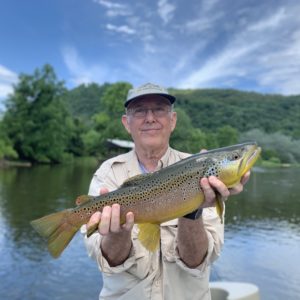Types of Trout We catch on our Fly Fishing Trips: Both around Asheville and East Tennessee
Western North Carolina and the tailwaters of East Tennessee have three main species of trout and a fourth kicker trout that is more of a unicorn. Within the three species there are several subspecies and I’ll describe them below and separate them geographically.
Asheville/Western North Carolina Trout Species
We have all three species of trout in our mountain streams around Asheville: Brook Trout, Rainbow Trout, and Brown Trout. The brook trout is our only native trout and they are found primarily at the very tops of the watersheds we fish. They are of the Southern Appalachian strain and there is a great video about their restoration linked here Those native fish are wild as well and are stream born and self-sustaining at this point. We also have wild rainbow and brown trout at lower elevations. They are also stream born now but were stocked here in the late 1800’s and early 1900’s. There is a great book about the history of rainbow trout stocking An Entirely Synthetic Fish, linked here. Those wild rainbow and brown trout live at elevations slightly lower than the brook trout. The wild populations don’t exist well together. The brown trout and rainbow trout are too aggressive to co exist with the brook trout. You can catch all three species in a day, but you have to catch the rainbows and browns and then hike up a few miles to find your brook. It’s a pretty cool time.
We also have stocked trout populations of all three trout around Asheville too. The most popular streams to find them are the Delayed Harvest Streams we often guide on during the fall, winter and spring. These three stocked populations are stocked in sizes ranging from 6 inches to 20 inches. Most fish fall in the 8-12 inch range. These fish are raised in the Bobby Setzer Hatchery on the Davidson River. They are sterile fish and can’t reproduce. That protects both our native and wild trout genetics from dilution from hatchery fish genes.
Tennessee Tailwater Trout Species: Watauga and South Holston Rivers
There are currently no brook trout in either the Watauga and South Holston. They are too far down the river system to have the native brook trout and the Tennessee Wildlife Resource Agency hasn’t stocked them in over a decade. There are lots of wild brown trout and that is what these rivers are known for. There are also many rainbow trout both stocked and wild. All the wild trout spawn in the main channel and a few of the tributaries of the Watauga. The rainbow trout stocked in both rivers come from the Dale Hollow federal trout hatchery and the Erwin federal hatchery. The stockers are primarily 6-12 inches when stocked. The TWRA does stock fingerlings occasionally. The Erwin hatchery also stocks their brood trout from August to January as they finish their egg harvests. Those fish are usually 16-22 inches long. There area FEW Lake Trout(Salvelinus namaycush) in both rivers, mostly right below the dams. The fish live in the lakes above the tailwaters and a few scoot through and over the dams and live to tell the tale. I have had clients catch two lake trout in 10 years so that tells you how few there are in the rivers. I have personally caught many lake trout while fishing the reservoirs so they are there.




